
-- Half Adder --
A half-adder circuit adds 2 bits (input) and gives a 2 bit answer (output). Here is the truth-table :
Inputs Outputs
|
A |
B |
C |
D |
explanation |
|
0 |
0 |
0 |
0 |
0 + 0 = 00 |
|
0 |
1 |
0 |
1 |
0 + 1 = 01 |
|
1 |
0 |
0 |
1 |
1 + 0 = 01 |
|
1 |
1 |
1 |
0 |
1 + 1 = 10 |
Looking at the output columns, we see that
So we conclude that the following circuit will work:

Carry D
This is called a half-adder because it isn't complete. It would
only work
for adding the LSB (least significant bits) of two integers.
-- Full Adder --
For the rest of the bits, there might be a CARRY from the previous
place.
That means we need a circuit that can add 3 bits and produce
a 2-bit answer.
This is called a full adder:
<-----
3 inputs ----------> <--- 2 outputs --->
|
A |
B |
C |
X |
Y |
Explanation |
|
0 |
0 |
0 |
0 |
0 |
0+0+0 = 00 |
|
0 |
0 |
1 |
0 |
1 |
0+0+1=01 |
|
0 |
1 |
0 |
0 |
1 |
0+1+0=01 |
|
0 |
1 |
1 |
1 |
0 |
0+1+1=10 |
|
1 |
0 |
0 |
0 |
1 |
1+0+0=01 |
|
1 |
0 |
1 |
1 |
0 |
1+0+1=10 |
|
1 |
1 |
0 |
1 |
0 |
1+1+0=10 |
|
1 |
1 |
1 |
1 |
1 |
1+1+1=11 |
This can be done without a Karnaugh Map by looking for patterns.
The grey section looks like an AND gate --> not A
and (B and C)
The yellow section looks like an OR gate --> A
and (B or C)
The blue section looks like an XOR gate --> not
A and (B xor C)
The green section is the opposite of XOR -->
A and not(B xor C)
Combining these, we get:
X = notA and (B and C) OR A and (B or C)
Y = not A and (B xor C) OR A and not(B xor C)
Using these observations, we can build the following circuit:

This is too complex. We'd like something simpler. A Karnaugh map isn't much help.
The real reason that a half-adder got it's name is that we can use two
half adders
plus an OR gate to make a full adder, like
this:

This can be created using an XOR and AND for each half-adder, like this:

You should memorize the circuit for half-adder, and this circuit which
uses
two half-adders to make a full-adder.
-- Register Arithmetic --
A CPU contains several single memory locations called registers.
Addition
involves adding 2 registers, 1 bit at a time, to produce an answer in a 3rd
register.
At each bit position, a full-adder is used, and it's carry
output is copied into
the input of the next full-adder, like this:

This is a 3-bit ripple adder with a full adder at each bit position.